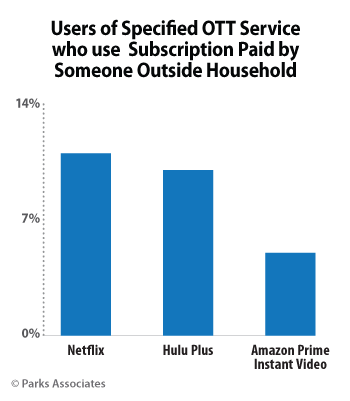OTT video 'account sharing' prevalent in the U.S.
Friday, May 15th, 2015
Nearly 60% of U.S. broadband households use OTT video services, but “Account Sharing” is prevalent
Digital media consumer research from Parks Associates reports 57% of U.S. broadband households access an OTT video subscription, but account sharing is a lingering challenge. According to a 3Q 2014 survey of U.S. broadband households, 8% are using a subscription OTT video account held by someone outside of their home, and 6% are exclusively using shared accounts to access subscription OTT video content. This finding equates to 11% of all households that are relying exclusively on shared accounts when using subscription OTT services.

“OTT video accounts for a disproportionate amount of content consumed when compared to expenditure—over one-third of video consumed per week is OTT, but it is only 9% of the household video budget,” said Brett Sappington, Director of Research, Parks Associates. “Account sharing is part of the larger problem in monetizing the strong consumer demand for OTT content. At CONNECTIONS™, we will discuss security of content services as well as the unique shifts in OTT consumption and revenues.”
The research ‘Segmentation: Sources and Spending’ shows 11% of Netflix subscribers, 10% of Hulu Plus subscribers, and 5% of Amazon Prime Instant Video subscribers are using an account paid for by someone else. Account sharing is highest among younger households, where 22% of those 18-24 who use an OTT service use a subscription paid by someone outside of their household. This OTT account-sharing research includes OTT services that are independent of pay-TV services.
“In terms of hours of consumption per dollar spent, consumers have every reason to shift spending to online video. While the all-you-can-eat subscription model is very popular, several OTT services are experimenting with models that blend advertising, subscription, and transactional options,” Sappington said. “Pay-TV providers will have to quickly move up the OTT learning curve, which is very different from the traditional pay-TV environment.”
Latest News
- Netflix posts first quarter 2024 results and outlook
- Graham Media Group selects Bitmovin Playback
- Dialog, Axiata Group, Bharti Airtel agree on merger in Sri Lanka
- Yahoo brings identity solutions to CTV
- Plex has largest FAST line-up with 1,112 channels
- TV3 migrates from on-prem servers to AWS Cloud with Redge